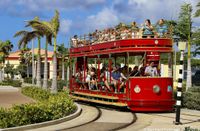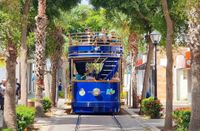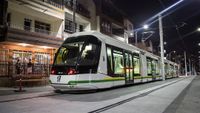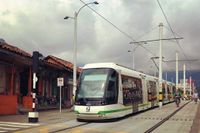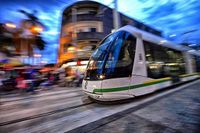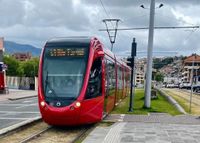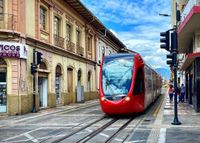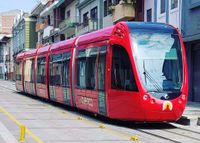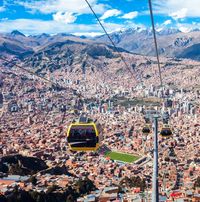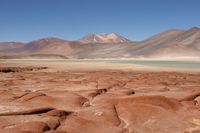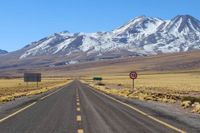SOUTH AMERICA: Trams between Andes and Pacific
3./5. - 17. November 2026
On this unique tram tour, we'll see the new (and sometimes not-so-new) networks in Aruba, Medellín, Cuenca, and Cochabamba. We'll stop in Bogotá to check if the new Chinese trams are already in operation and pay homage to the trolleybus in Quito. In La Paz, we'll visit the last remaining trams of the classic 1950s system and take a boat trip on Lake Titicaca. Individual itineraries can be requested at any time.
UPDATE December 1, 2025: Some participants have expressed interest in also visiting the Lima Metro. Lima is no longer included in the tram itinerary because the only operational car (#97) is no longer running and has been moved to a museum. The museum line has been decommissioned and the museum is officially closed for renovations (as of summer 2025). From a travel logistics perspective, it would be ideal to visit Lima during the pre-program in Aruba to minimize the number of additional flights required within South America. Departure from Europe and arrival in Lima would be on 3. November. Metro on 4. November, flights via Bogota to Quito on 5. November and meeting with the main group. The more bookings there are for this optional program, the more affordable it will be :-)
TOUR PROGRAM
Pre-tour Aruba:
Day 1
3. November 2026
Individual arrivals at Aruba airport. International flights are not included in the tour price, as the choice of airline for the transatlantic flight depends on the desired program within South America. KLM would be the first choice; I am happy to book tickets at current daily rates. Departures from Europe in the morning, arrival in Aruba in the late afternoon. Transfer to the hotel. Dinner and overnight stay in Oranjestad.
Day 2
4. November 2026
The tram in Oranjestad, the capital of Aruba, officially opened on February 19, 2013, and runs on a 1.9 km (1.2 mi) route connecting the cruise terminal on the outskirts of Oranjestad with the city center. Of the original four vehicles (two single-decker trams in green and orange, and two double-decker, open-top trams in blue and red), only the double-deckers are currently in service. The single-deckers are currently out of service and since the vehicles were custom-built in the USA based on historical models, obtaining spare parts is proving difficult. The tram's operation depends on the number of cruise ships; I have requested that we see all the vehicles during our visit to the island, regardless of demand from the ships. Dinner and overnight stay in Oranjestad.
Day 3
5. November 2026
Time until the afternoon to enjoy the colorful trams. Afterwards transfer to the airport and, with a change of planes in Bogota (Colombia), onward to Quito (Ecuador). Arrival there in the late afternoon. Transfer to the hotel, meeting with the participants of the main group, dinner, and overnight stay in Quito.
End of the pre-tour.
Main Program
Day 3
5. November 2026
Individual departures from Europe to Quito. International flights are not included in the tour price, as the choice of airline for the transatlantic flight depends on the desired program within South America. KLM via Amsterdam would be the first choice; I am happy to book flight tickets at current daily rates. Departures from Europe are in the morning, with arrival in Quito in the late afternoon. The official tour program begins upon the participants' arrival at Quito Airport. Transfer to the hotel. Dinner and overnight stay in Quito.
Day 4
6. November 2026
The Quito trolleybus system is the only trolleybus operation in Ecuador. Until the Quito Metro opened in 2023, it formed the backbone of public transportation in the Ecuadorian capital. The necessary number of vehicles for smooth and regular operation was never reached due to a high number of defective vehicles (in some years over 50%). After diesel buses were partially used in the trolleybus schedule, a decision was made in 2024 to order a total of 60 new vehicles from China. These all got delivered in the meantime and have completely eliminated the original Mercedes-Benz vehicles. A visit to the trolleybus depot has been requested. Optional visit to the Metro. Evening flight to Cuenca. Dinner and overnight stay in Cuenca.
Day 5
7. November 7 2026
The Cuenca tram, "Tranvía de Cuenca," is one of the highest tram systems in the world, operating at 2,550 meters above sea level. Part of the route utilizes the Alimentation Par Sol (APS) system, an underground power supply system that avoids overhead lines in the historic city center. The tram runs with 14 Alstom Citadis X051 articulated trams on the 10.3 km route with 20 stops. The line largely has its own dedicated track and uses grassed tracks outside the city center. Currently, there are no concrete plans to expand the Cuenca tram network. The existing line was only fully operational in 2020, and the city administration is currently focused on optimizing operations and improving integration with other modes of transportation. Full-day filming and riding the Cuenca tram. Dinner and overnight stay in Cuenca.
Day 6
8. November 2026
Another day is available to enjoy the regular tram services in the city. Dinner and overnight stay in Cuenca.
Day 7
9. November 2026
We will be haeding towards Bogota this morning. We first fly to Quito and change planes to Bogota, arriving there in the late morning. Bogota is currently the only South American capital city without a rail-based public transport system, but after more than 70 years of planning a metro system for the city, the first "Tranvia" vehicles from China arrived in Bogota in September 2025 to be used "someday" on the line currently under construction. Bogota's original tram system was decommissioned in the 1950s, and remnants of the tracks, including switches and crossings, are still visible in the city. We will visit the old and new tracks; if the first section of the Tranvia has already been inaugurated, we will also chase the scheduled services. Dinner and overnight stay in Bogota.
Day 8
10. November 10 2026
With a packed breakfast in your bag you will be heading to the airport early this morning for the flight to Barrancabermeja. Here, in the country's oil refining capital, the longest operating railway line in Colombia starts, leading to Puerto Berrio. Quaint, homemade diesel railcars provide a connection to the outside world for the many villages along the route, as there are hardly any car-worthy roads. The regular trains are usually packed with all sorts of goods that traveling merchants want to bring to the villages. We've chartered a "Ferobus" and will travel the approximately 110 km route, stopping frequently for photos. This is truly authentic, rural Colombia, far from the big cities. In Puerto Berrio, the bus will be waiting with our luggage to take us to Medellín. Lunch will be en route, followed by dinner and overnight accommodation in Medellín.
Day 9
11. November 2026
The tram in Medellín is the first and so far only Translohr system in South America. Translohr was awarded the contract because it was hoped that the system could better handle Medellín's steep hills than conventional trams. The double-track line is only 4.3 km long and serves nine stops. Twelve five-section, bidirectional STE5 trams are in operation. Cable cars also depart from two of the tram stops, providing access to the city's hills. Dinner and overnight stay in Medellín.
Day 10
12. November 2026
Six cable cars and two metro lines await our visit. The first cable cars were built in the 1980s and connect the city center with the outlying districts located on the hills. These were formerly illegal settlements with very poor connections to urban life and a lot of gang violence. The cable cars made it easier for residents to find work in the city, and additional businesses along the cable car stations created modest but regular incomes outside of the illegal sector. Today, even tourists can enjoy the beautiful views of Medellín from the Miradores (viewpoints). In the late afternoon, we fly via Bogotá (with a layover) to La Paz. Arrival there around 2:15 a.m.! Overnight stay in La Paz.
Day 11
13. November 2026
At the "Museo de Locomotoras" in Puerto Guaqi, we find two of the former tram cars from La Paz – another system that fell victim to the automobile craze of the 1690s-70s. Besides the two tram cars, the museum also houses a very interesting collection of diesel locomotives and railcars. Afterwards, we board an excursion boat and cruise across the legendary Lake Titicaca. Lake Titicaca is the largest freshwater lake in South America and lies on the Altiplano plateau in the Andes (3,812 meters above sea level). It is the highest commercially navigable lake in the world and is considered the birthplace of the Inca civilization. It is home to numerous historical sites, including the famous Isla del Sol and the floating islands of the Uros. In the evening, return to the hotel. Dinner in Copacabana and overnight stay in La Paz.
Day 12
14. November 2026
After breakfast, we have a ride on the cable car at El Alto before heading to the airport forvthe short domestic flight to Cochabamba. The Cochabamba tram, also known as "Tren Metropolitano de Cochabamba", is a modern light rail system with current plans for three lines (red, green, and yellow), a total of 43 stops and a length of about 42 kilometers, mostly single-track. However, only parts of the network are in operation right now: the red and green lines use the platform of former railway lines, the yellow line runs mainly elevated over the Río Rocha. The central hub station is the newly built Estación Central San Antonio. Low-floor trams from Stadler are used. Inaugurated in September 2021, "Mi Tren" is the first rail-based public transport system in Bolivia! Dinner and overnight stay in Cochabamba.
Day 13
15. November 2026
We will spend another full day along the tram tracks in Cochabamba. Dinner and overnight stay in Cochabamba.
Day 14
16. November 2026
With the creation of the Tren Metropolitano, the railway infrastructure was completely redesigned. A new station and a new depot for the light rail system were built, and the old railway junction was closed. We have one last day to take more photos of this diverse operation. Dinner and overnight stay in Cochabamba.
Day 15
17. November 2026
The tram tour ends in Cochabamba today. Those flying home begin their journey this morning and will arrive in Europe tomorrow. Cochabamba is certainly not the aviation hub of South America, or even Bolivia... the return flight to Europe requires at least two local flights to reach the nearest international airport. These flights are not included in the tour price; KLM and Air France would be the first choice, and I am happy to book tickets at current daily rates.
Anyone who would like to stay in South America longer is welcome to let me know their wishes; I will forward them to the local agencies. Machu Picchu? Uyuni Salt Flats?
FLIGHT LOGISTICS
For long-haul flights, KLM (via Amsterdam) and Air France (via Paris) are the first choice. I can book favorable fares for tour operators with both airlines (for Economy, Premium Economy, and Business Class). But here too, the rule applies: those who book early get the best price!
Flights within South America are mainly operated by the Colombian airline and Lufthansa partner, Avianca. I have created a group booking for all (currently 7) necessary flights for all participants of the program from November 5th to 17th. The flight network within South America is sparse, and many flights take place during off-peak hours, early in the morning or late in the evening.
TOUR PRICE
ARUBA Pre-tour (3.-5. November 2026)
740 Euro per person in a shared double room (for registrations until 31. December 2025)
790 Euro per person in a shared double room (for registrations from 1. January 2026)
340 Euro single room supplement
Minimum number of participants 5, maximum number of participants 12. Registration deadline July 31, 2026, thereafter on request.
Main program (5.-17. November 2026)
6.570 € per person in a shared double room (for registrations until 31. December 2025)
6.790 € per person in a shared double room (for registrations from 1. January 2026)
720 € single room supplement.
Minimum of 15 participants, maximum of 25. Registration deadline: 31. July 2026, thereafter on request.
Participation in partial programs is possible; please contact me for details.
SERVICES:
- 12 nights in 3-4* hotels in a double room with breakfast (single room available for a supplement)
- 7 AVIANCA Airlines flights within South America in economy class (number of flights depends on the flight schedule valid at the time of travel: UIO-CUE-UIO-BOG-EJA, MDE-BOG-LPB-CBB) and 23 ks checked bags
- Other meals as per itinerary
- All tram-related visits, tours, and permits as per itinerary
- Charter train Barrancabermeja - Puerto Barrio
- Cruise on Lake Titicaca
- Transfers and excursions in comfortable local standard buses
- Tour guide: Luc Koenot (German, English, French, Dutch speaking) Auruba-Cochabamba
Overall tour guide: Peter Patt (German, English, French speaking) Quito-Cochabamba
NOT INCLUDED:
Long-haul flights,
tips (approx. €15-20 per day per participant on average),
personal expenses,
travel insurance (luggage, international health, trip cancellation) .
GOOD TO KNOW:
German citizens can enter Aruba, Bolivia, Ecuador, and Colombia without a visa. A passport, valid for at least six months beyond the date of entry and with sufficient blank pages for stamps, is mandatory. If your passport is in poor condition, such as frayed pages, stains, or damages, you may face a denied entry. An electronic entry card is now required for almost all countries. For complete entry requirements, please visit the website of the Federal Foreign Office. Specific travel vaccinations are not required; for details, please consult the Institute for Tropical Medicine . Travelers of other nationalities should inquire about their specific entry requirements.
This trip will be physically demanding. Due to the long distances and sometimes less-than-ideal transport options, we will be traveling for extended periods with irregular mealtimes on some days of our itinerary. We will be traveling from sea level to altitudes of over 3,000 meters above sea level and will rarely have sufficient time to acclimatize. Occasional short nights are to be expected. I would be delighted if you would like to join us, however, I urge you to be honest with yourself and assess whether you are up to these physical challenges. Please be sure to consult your doctor!
South America is a continent full of contrasts and surprises. The people are friendly and hospitable, but it's important to be prepared for some cultural differences. Time often plays a different role here. The word "mañana" ("tomorrow") was certainly invented in South America or introduced by the colonialists. Please let go of the idea that everything has to be done immediately and as agreed during this trip. And if certain things need to be discussed for the tenth time, then so be it. We won't get anywhere with pedantry and insistence on being right. And if something gets stuck and doesn't go as planned, please remain calm. It's much better to adopt some Latin American ease and let things take their course than to become frantic without any prospect of success. Be patient and enjoy the relaxed atmosphere.
South America doesn't exactly have a reputation as a "safe" travel destination. Our tour guides are very well connected locally and will make sure we don't wander off into the wrong neighborhoods. Pay particular attention to your valuables and be vigilant, especially in large cities and at tourist attractions. With a bit of caution and common sense, you can enjoy your trip without worry.
Please have a valid travel insurance: no one is immune to unpleasant health surprises or life events that make travel impossible. Cheap flights are often only partially reimbursed by the airline, and hospital and doctor visits abroad can quickly become very expensive. I work with the affordable and professional Hanse-Merkur insurance company, which offers attractive rates for all types of travel insurance: you can find an offer for international health insurance here , and for trip cancellation insurance (and all other plans) here.
This trip is not suitable for people with reduced mobility. Please note that our trip involves boarding and disembarking on uneven ground, with high-entry vehicles, or in environments that do not conform to German standards. If you are unsure whether this trip is suitable for you, please contact me.
© Bilder auf dieser Seite: A. Morales, Hotel Alpha, Tourismo Peru, V. Lamar, P. Patt
